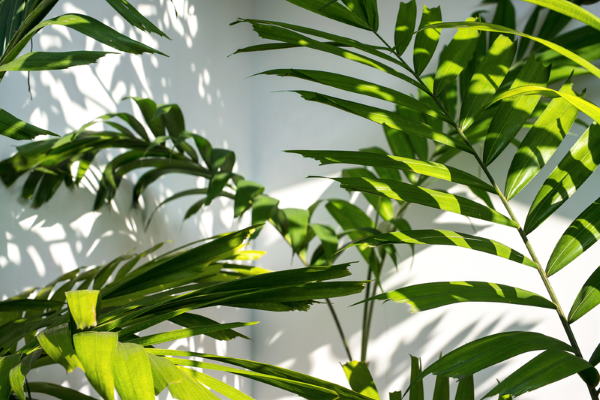Small Palm Trees to Grow Indoors
You can't beat palms for adding captivating style to a room. Even small palm trees will stand out, transforming any space into a lush, tropical oasis.
From spectacular sprawling fans that command attention to dramatic fountain shapes with wispy fronds that soften a room, palms make classy indoor accents.
They are tropical by nature, so unless you live in a year-round warm, humid climate, consider these beautiful plants indoor palms. Not all palm trees species do well indoors, however, because of lower light levels and low humidity. So I'm only including the types of palms that will thrive in an average house environment. You do have a lot of choices available.
 Add a tropical vibe to any room with small palms. Photo ©Andriy Bezuglov
Add a tropical vibe to any room with small palms. Photo ©Andriy BezuglovPalm Tree Buying Tips
You'll find small palm trees for sale in garden centers, supermarkets and big box stores. Before you buy a small palm, check it over to ensure it's healthy. Unfortunately, some are neglected in a store or are exposed to less-than-ideal conditions.
Here are a few tips to help you choose a healthy palm:
- Pass up any with several dead fronds -- a sign of dry soil, salt build-up or low humidity.
- Check the foliage for insects, especially spider mites. You'll notice webbing between fronds and speckling on the leaflets. Also watch out for scale (they look like brown discs on the undersides of leaves) and mealy bug (they look like small specks of cotton).
- Avoid any with soggy soil that smells bad. Poor drainage or overwatering can cause root rot. That's not a good start for your new palm.
- Black or brown patches on fronds are a fungal disease that needs to be treated. Pass this up too. You don't want to bring this disease into your home because it may affect your healthy house plants.
Small Palm Trees
Some palms are more adaptable to indoor living than others. If you want easy success with palms, I highly recommend these small palm trees:
Caring for Palm Trees Indoors
Wondering when to repot? Palms grow slowly indoors, and won't need repotted for a couple years. Their root systems are small and can be kept in the same pot. Here's a trick to keep your palm tree small: gently ease the plant out of its pot and remove up to one-third of its roots. Add more fresh potting mix to the bottom of the pot before returning the palm. Fill in the edges of the pot with more potting mix, tamping it gently. Thoroughly water your newly potted plant.
Water regularly. Palms should not dry out completely. However, they won't tolerate soggy soil. It's a good idea to use a water gauge for large potted plants, rather than guess how much moisture is deep in the container.
Raise the humidity. Tropical plants are healthiest when they are surrounded with humidity, as in their native habitats. Indoor humidity can drop drastically in the winter months, and will cause brown leaf tips. If indoor air is dry, the best way to boost humidity near your indoor palm trees is to use a cool-mist room humidifier.
Great Pretenders: Palm Look-Alikes
These plants are deceptive, pretending to look like palms. Actually, they're less fussy about light, watering and humidity than real palms.
If you want eye-catching trees for your home that are easy to please, give these plants a whirl.
Sago palm has growing habits like a pine tree, but features fronds like a large palm. Give it bright light and keep it lightly moist all year and it will thrive beautifully in your home.
Yucca cane plant succeeds where other houseplants fail because it tolerates a range of indoor conditions. Yuccas grow best in bright light with plenty of sunshine. Average room temperatures and infrequent watering suit this plant just fine. Place one in a sunny spot and you'll add instant architectural interest to your home. Its long, evergreen foliage make it a stand-out in any brightly lit room.
Green Thumb Tip
Palm fronds tend to be dust-catchers. Wipe them with a damp cloth to keep them clean.
Or clean the foliage with a warm shower: move small palm trees outdoors on a warm day and spray with warm water. Keep palms out of direct sunlight and allow to dry outdoors in a shaded spot.
Another desert dweller is the Ponytail Palm, a semi-succulent that's easy to grow just about anywhere. Give it a place in the sun and you'll keep it healthy. Its unusual bottle-shaped base stores water, so occasional lack of water will not harm it at all.
What I like best about Ponytail Palm are the long, strappy leaves that look like a pony's tail. Eye-catching and carefree, what more could you ask?


